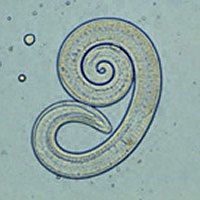
Photo from wikipedia
The prevalence of gastrointestinal helminths was investigated in sixty-six commercial non-caged layer flocks. Twenty-nine flocks were housed indoors in aviaries or floor systems, nineteen flocks were kept in conventional free-range… Click to show full abstract
The prevalence of gastrointestinal helminths was investigated in sixty-six commercial non-caged layer flocks. Twenty-nine flocks were housed indoors in aviaries or floor systems, nineteen flocks were kept in conventional free-range systems with outdoor access, and eighteen flocks in organic free-range systems. Flocks were investigated at end of rearing (mean age 17 weeks), peak of egg production (mean age 38 weeks) and before slaughter (mean age 74 weeks). Four different methods were applied to determine worm infestation. During necropsies, worm infestations were recorded and mucosal scrapings were evaluated for the presence of worm eggs. Faecal samples from each flock were investigated by simple flotation method and McMaster counting technique. No gastrointestinal helminths were found in pullets. During production, 87.9 % of the layer flocks were infected with at least one nematode species at the peak of production. The prevalence further increased significantly up to 98.5 % at the end of production (p=0.05). This increase could be ascribed mainly to infections with Ascaridia (A.) galli and/or Heterakis (H.) gallinarum which were most prevalent in all husbandry systems. Furthermore, their prevalence increased significantly with the age of birds (p=0.023; p < 0.001). With regard to the husbandry system, the prevalence of Capillaria spp. was significantly higher in flocks from outdoor systems compared to flocks that were kept indoors. Cestodes were only detected at the end of production with a prevalence of 15.2 % and significantly more flocks with access to outdoor run were found positive. Interestingly, H. gallinarum was found with a high prevalence indoor and in outdoor systems. Anthelminthic treatment did not impact the prevalence of nematode infections. Comparing four different methods for the detection of helminths it was revealed that their efficiencies varied depending on the worm species. Overall, the simple flotation method was superior to detect A. galli and Capillaria spp. This method proved also very efficient for the detection of H. gallinarum but the additional evaluation of the worm infestation during necropsy increased the level of prevalence. Cestodes were mainly found during necropsies when the worm infestation was evaluated. The detection of parasite eggs in mucosal scrapings from the intestines was the least effective method for all helminths. These findings lead to the recommendation to combine faecal investigations with an evaluation of the worm infestation during necropsy of at least five birds.
Journal Title: Veterinary parasitology
Year Published: 2021
Link to full text (if available)
Share on Social Media: Sign Up to like & get
recommendations!